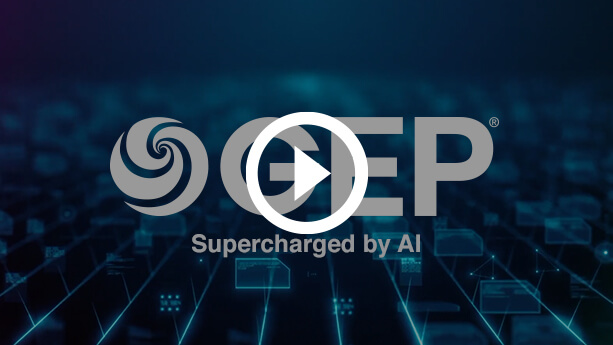What Does an AI-First Source-to-Pay Solution Look Like?
Procurement has traditionally involved a lot of transactional, time-consuming tasks. AI-first solutions can automate many of these tasks to allow you to focus on higher level projects across all the different functions of the source-to-pay process – risk mitigation, opportunity identification, value creation, strategic transformation.
As an AI-first company, we are committed to leaving no stone unturned when it comes to taking advantage of this new emerging technology.
There are already many use cases for AI in the entire source-to-pay process, and we’re continuing to discover more. In listening to our customers, here are some of the ways in which AI solutions are already making a big difference for them.
Spend Analysis
For quite some time, artificial intelligence has been the driving force behind effective spend analysis, particularly in data normalization and categorization opportunity assessment. In this context, GEP has been at the forefront, leveraging proprietary AI algorithms to enhance the efficiency and efficacy of spend analysis.
However, the emergence of prospective generative AI is poised to elevate this transformation further, introducing an additional layer of utility and augmenting existing knowledge.
Previously, extracting intelligence from spend data required proficiency in drag-and-drop reporting and business intelligence tools. With generative AI, querying and deriving insights from spend data will become even more effortless, as professionals can pose questions in natural language. For instance, complex inquiries like identifying the most savings in a specific category based on a territory or business unit will be answered credibly and comprehensibly through these AI-powered tools.
The ultimate logical extension of this advancement lies in predictive capabilities. Not only will AI enable the identification of likely patterns of future spend based on historical data, but it will also leverage real-time data and other sources of intelligence to deliver highly accurate predictions for demand and spend forecasting. This predictive prowess will empower procurement and supply chain professionals to make data-driven decisions with unparalleled precision and foresight.
Sourcing
AI's impact on sourcing is evident in its ability to gather and analyze vast amounts of data swiftly. Procurement professionals can leverage this capability to identify the most suitable suppliers based on factors such as pricing, quality and sustainability. Machine learning algorithms further enhance the process by predicting supplier performance, enabling data-driven decision-making during supplier selection while mitigating risks.
Fundamentally, sourcing revolves around two vital questions: "Who should I buy from?" and "What are they going to charge me?" AI, especially generative AI, plays a pivotal role in answering these questions. The technology allows professionals to quickly determine the most appropriate suppliers based on specific criteria, transforming what was once a potentially weeks-long process into a single chat session.
Beyond supplier selection, generative AI helps optimize the bidding process, analyze responses from suppliers and determine the best combination of suppliers for optimal pricing and supply protection.
Moreover, AI can accelerate work with suppliers, auto-creating RFX documents and facilitating informed decision-making during the award phase. By harnessing historical data and real-time bid information, AI empowers professionals to efficiently manage sourcing events, evaluate supplier performance and adapt to changing requirements.
Supplier Management
The advent of AI has enabled the concept of a 360-degree view of suppliers, encompassing a comprehensive understanding of every aspect related to them. This includes not only the products or services they currently supply but also the existing contracts and certifications in place, service performance evaluations, customer satisfaction, invoice accuracy and payment timeliness.
AI-first solutions empower professionals to make data-driven decisions by providing insightful recommendations for supplier optimization. Procurement teams can identify strategies to enhance supplier effectiveness or develop contingency plans for potential risks. AI’s analytical capabilities play a crucial role in assessing supplier performance, considering factors like on-time delivery and track record.
Generative AI can significantly enhance the supplier onboarding process by automating and expediting repetitive tasks such as data verification, document processing and communication. With AI-first solutions, suppliers can enjoy a streamlined experience, reduced manual effort and quicker turnaround times, leading to improved efficiency and a smoother onboarding journey.
In terms of risk management, AI is indispensable. It assists in tying together various risk factors associated with suppliers, trading partners and the supply chain. By comprehensively assessing and monitoring risks, professionals can better understand supply and supplier vulnerabilities and take proactive measures to mitigate potential disruptions.
AI-driven automation can recommend alternative or second-tier suppliers in case of supply chain disruptions, and these suppliers are pre-vetted for suitability. This automation streamlines the process, enabling professionals to respond swiftly and efficiently to supply chain challenges.
Contract Management
One of the essential roles AI plays in contract management is risk mitigation. AI can swiftly identify both contract risk and legal language risks and non-compliance issues within contracts, aligning them with organizational policies and legal requirements. This capability empowers procurement and legal teams to make informed decisions, avoiding potential pitfalls and ensuring contractual agreements are secure and beneficial.
Furthermore, AI empowers users to search and analyze contracts at scale. Teams can inquire about the acceptance of certain contract terms in the past, explore clauses and assess supplier performance against agreed service levels and prices.
With generative AI, contract managers can perform cross-cube querying, accessing data from multiple sources seamlessly and efficiently. This technology enables procurement professionals to make data-driven decisions swiftly and accurately, ultimately enhancing the contract management process and driving better business outcomes.
Procure-to-Pay
Automating purchase requisition approvals through intelligent workflow systems through AI enables procurement cycles to become faster and more efficient, facilitating streamlined and error-free processes.
Machine learning algorithms are instrumental in forecasting future demand, leading to improved inventory management. This ensures timely procurement of essential items, reducing stockouts and overstock situations, thereby enhancing operational efficiency.
Generative AI brings remarkable innovations to guided buying. By transforming the buyer experience into an interactive request interaction, where questions and answers lead to automatically generated, compliant purchase requisitions, procurement teams can ensure maximum contract utilization and adherence to business and budget rules.
Invoice Management and Payment
When invoices align seamlessly with purchase orders and goods receipts, AI enables automatic payment processing, streamlining routine tasks and ensuring efficient payment cycles.
However, where exceptions arise, AI becomes instrumental in managing them with the same level of scrutiny as a human expert. Leveraging machine learning capabilities, AI can assess price and service delivery against predefined tolerances, making informed decisions on whether an invoice should proceed for payment or require further action.
This intelligent exception management, otherwise known as invoice reconciliation, not only ensures accuracy and compliance but also reduces manual intervention, saving time and resources for procurement teams. With AI's prowess in handling exceptions, invoice management becomes more efficient, transparent and adaptable, paving the way for enhanced financial control and operational excellence.
Integrating Source-to-Pay and Supply Chain Into the Same Landscape
Driven by the expansion of source-to-pay capabilities and the need for greater efficiency in customer operations, source-to-pay and supply chain processes are converging. The integration of these two critical functions is becoming an essential part of the procurement landscape.
AI plays a pivotal role in this convergence by leveraging the integrity of unified data within a single platform. With AI's, especially generative AI, ability to analyze and query cross-domain data comprehensively, it transforms information into actionable intelligence across the organization, irrespective of individual roles.


